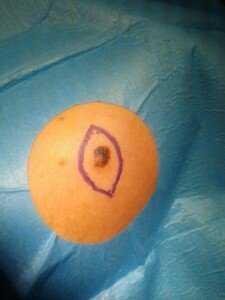Does the stabbing pain around your melanoma WLE site relate to the cancer itself? Or is something else going on?
Melanoma is frightening enough without having to suffer from sharp pains around the site of your wide local excision.
This can easily make you wonder if all the cancer was “caught,” or if the tumor is already growing back with a vengeance.
It may also make you wonder about possible damage to nerves.
“A wide local excision requires the removal of the tumor with a margin of healthy skin around it,” says Adam J. Mamelak, MD, a board certified dermatologist and founder of Sanova Dermatology in Austin, TX.
“The excision often is made to the deep fatty tissue or fascia under the skin,” continues Dr. Mamelak.
“I always tell patients, when you cut through the skin, you often cut through some superficial vessels and nerves in the skin.
“This can affect sensation to the area, often with numbness, tingling and sometimes even deep stabbing pain.
“Nerve ‘damage’ is a bystander effect of surgery and a common side effect. Like the skin, some of these irregular sensations will heal and improve over time.
“In general, nerves regrow slower than the skin cells, so irregular sensations can last a number of months.”
Solutions to Sharp or Stabbing Pain Around the Melanoma WLE Site
Dr. Mamelak explains, “This can be treated conservatively and by massaging the area.
“Often, a local steroid injection in the skin around the wound can help as well.
“In severe cases, topical capsaicin and a number of oral therapies can help with nerve pain as well.”
 Dr. Mamelak focuses on the full breadth of dermatologic care, from cosmetic skin solutions to advanced skin cancer removal. He’s founder of the Austin Mohs Surgery Center, which is dedicated to the treatment and management of skin cancer.
Dr. Mamelak focuses on the full breadth of dermatologic care, from cosmetic skin solutions to advanced skin cancer removal. He’s founder of the Austin Mohs Surgery Center, which is dedicated to the treatment and management of skin cancer.
 Lorra Garrick has been covering medical, fitness and cybersecurity topics for many years, having written thousands of articles for print magazines and websites, including as a ghostwriter. She’s also a former ACE-certified personal trainer.
Lorra Garrick has been covering medical, fitness and cybersecurity topics for many years, having written thousands of articles for print magazines and websites, including as a ghostwriter. She’s also a former ACE-certified personal trainer.
.

























